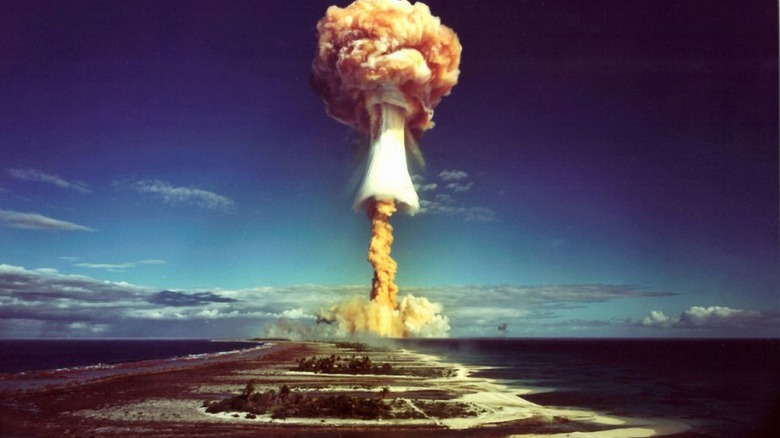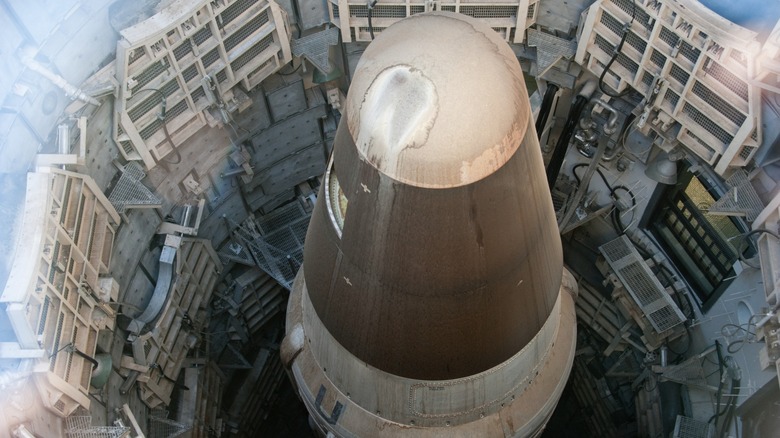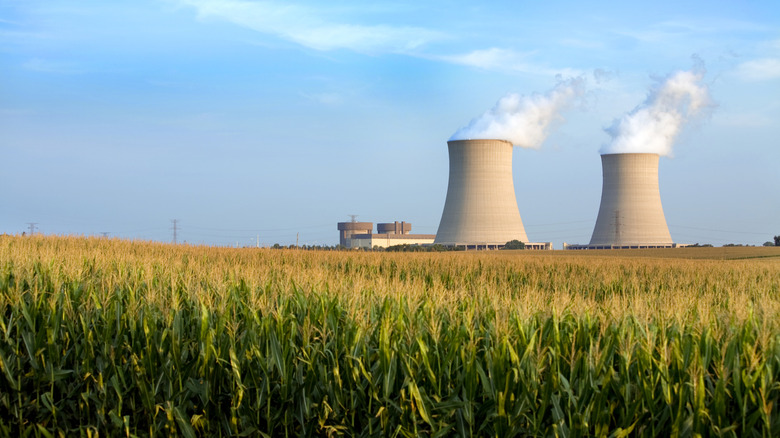Atomic Vs. Nuclear Bombs: Is There A Difference?
A pivotal scene in the explosive hit biopic and Best Picture winner, "Oppenheimer," involves America's top scientists discussing whether or not to develop an even more potent nuclear weapon — the Hydrogen Bomb — in reaction to the Soviet Union conducting its first nuclear test. The idea was that, by building this new thermonuclear weapon conceived by scientist Edward Teller, the United States would have once again have the upper hand in the earliest days of the Cold War, because the so-called "H-Bomb" would be much more powerful detonated bomb than the "A-Bomb" weapons set off by the Soviets and Americans. The "A" stands for "atomic," and was quickly adopted as a name for the earliest nuclear weapons.
The A-Bomb wasn't just tested by the U.S., as it was infamously used twice against an enemy combatant — the only times to date that nuclear weapons have been used in war — when it was dropped over the Japanese cities of Hiroshima and Nagasaki in 1945, bringing a swift end to World War II. Eventually, Teller's H-Bomb would be developed by both sides and dominate the nuclear arsenals of each country, as well as several others, with over 40,000 thermonuclear weapons built by the late 1980s. But, besides the fact that A-Bombs are less powerful, what makes them different from H-Bombs? In fact, what's the difference between atomic bombs vs. nuclear bombs, if there even is one? The answer depends on how the explosion is triggered.
Technically, all atomic bombs are nuclear bombs, as they use fission — a nuclear reaction — as their power source (as opposed to traditional bombs, like TNT and dynamite, which use chemical, not nuclear, reactions). However, there is a key difference between atomic weapons and thermonuclear weapons, such as the H-Bomb, because the latter uses nuclear fusion in addition to fission reactions.
Thermonuclear bombs use tiny A-Bombs to detonate
All atomic bombs are nuclear bombs, but not all nuclear bombs are atomic. While any weapons using nuclear reactions involve, by definition, the use of atoms, for whatever reason, the word "atomic" has now become used to describe weapons that use nuclear fission as their main power source. Fission creates energy when the nucleus of an atom is split apart by the impact of another particle, often a neutron that is fired at it. If the right kind of material is packed together in the right way, such as refined uranium or plutonium, a fission chain reaction, where more and more atoms are split by the neutrons emitted from previous splits, can cause an instant and very powerful explosion.
Like atomic bombs, thermonuclear bombs are also nuclear weapons, but they instead use fusion rather than fission. When two atoms are forcibly merged into one, the new combined atom has slightly less mass. Because E=MC², that leftover mass turns into energy, which fuels the nuclear explosion. Hydrogen atoms are the simplest in nature, which is why they're used for thermonuclear reactions and why the earliest weapons were called "H-Bombs." Using fusion energy is literally harnessing the power of the sun, which itself is fueled by the constant fusion of two hydrogen atoms into a single helium atom.
It takes a lot of energy to fuse atoms together, which is why thermonuclear weapons actually have tiny A-bombs built inside them. That is to say, the primary stage of a thermonuclear weapon involves the use of conventional explosives to split uranium atoms and create fission, which in turn creates enough energy to combine hydrogen isotopes and detonate a thermonuclear explosion. All of this occurs in a fraction of a second.
Is a dirty bomb considered a nuclear weapon?
While fusion has created the deadliest weapons known to man, military strategists also see fusion reactors as a way to improve offense and defense capabilities in other ways, including air superiority. This could be one result if we scientists eventually figure out how to use nuclear fusion to produce vast amounts of cheap energy that can replace fossil fuels and even solar and wind energy. This also goes to show that when we put our minds to it, we can think of all kinds of ways to wield nuclear physics as a weapon, perhaps in ways that are more dangerous than a nuclear bomb.
However, not all radioactive weapons need to directly use fusion or fission to be deadly. For instance, a dirty bomb gets a lot of buzz as a potential weapon that can be used by terrorists or smaller states. That's because it's a lot easier and more practical to build than a traditional atomic or thermonuclear weapon, which requires refined uranium or similar fuels. A dirty bomb, or radiological dispersal device (RDD), is really just a traditional explosive with radioactive material wrapped around it. When the bomb goes off, this material scatters and contaminates the local area and people within it.
No fusion or fission is creating the energy in the blast, and the "dirty" radiation must already exist within the material, whether it's medical equipment or waste from a nuclear power plant. That means that a dirty bomb, despite being radioactive and very lethal, is neither an atomic nor a nuclear weapon. It's also far less destructive, since a dirty bomb would wreak havoc for a few blocks or maybe a few miles, whereas thermonuclear weapons can be hundreds of times more powerful.


